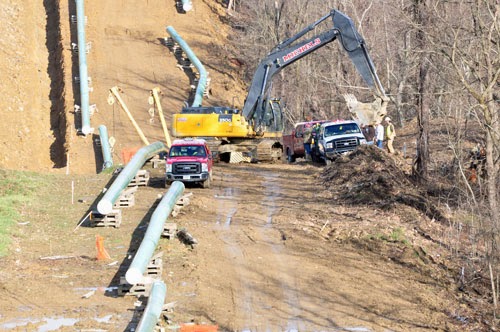LAWS FOR NEW PIPELINES
Certification of New Interstate Natural Gas Pipeline Facilities
m
June 16, 2011 - Dominion Transmission, Inc - Docket No. CP10-448-000
m
FERC balances the public benefits
against the potential adverse consequences. (14)
“Determine whether the applicant has made efforts to eliminate or minimize
any adverse effects the project might have on landowners and communities
affected by the route of the new pipeline”. (15)
FERC will evaluate the project by balancing the evidence of public benefits
to be achieved against the residual adverse effects. (15)
Only when the benefits outweigh the adverse effects on economic interests
will the Commission proceed (15)
14.
The Statement of Policy on the Certification of New Interstate Natural Gas
Pipeline Facilities (Certificate Policy Statement) provides guidance as to how the Commission will evaluate proposals for certificating new construction.
The Certificate Policy Statement established criteria for determining whether there is a need for a proposed project and whether the proposed project will serve the public interest.
The Certificate Policy Statement explains that in deciding whether to authorize the construction of major new pipeline facilities, the Commission balances the public benefits against the potential adverse consequences.
The Commission's goal is to give appropriate consideration to the enhancement of competitive transportation alternatives, the possibility of overbuilding, subsidization by existing customers, the applicant's responsibility for unsubscribed capacity, and the avoidance of the unnecessary exercise of eminent domain or other disruptions of the environment.
15.
Under this policy, the threshold requirement for companies proposing new projects is that the applicant must be prepared to support the project financially without relying on subsidization from its existing customers.
The next step is to determine whether the applicant has made efforts to eliminate or minimize any adverse effects the project might have on the applicant's existing customers, existing pipelines in the market and their captive customers, or landowners and communities affected by the route of the new pipeline.
If residual adverse effects on these interest groups are identified after efforts have been made to minimize them, the Commission will evaluate the project by balancing the evidence of public benefits to be achieved against the residual adverse effects.
This is essentially an economic test. Only when the benefits outweigh the adverse effects on economic interests will the Commission proceed to complete the environmental analysis where other interests are considered

.jpg)

